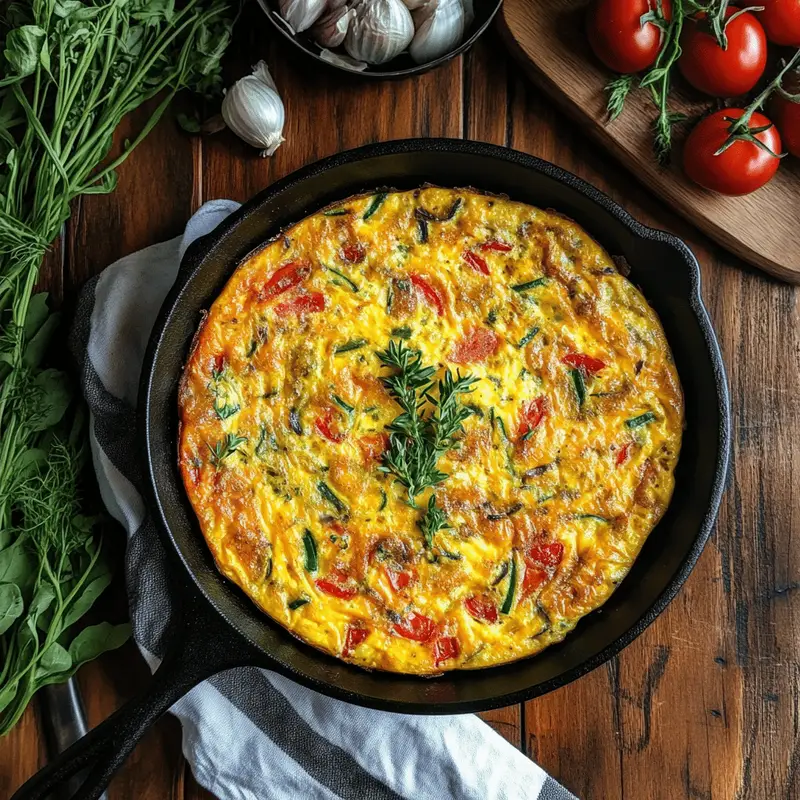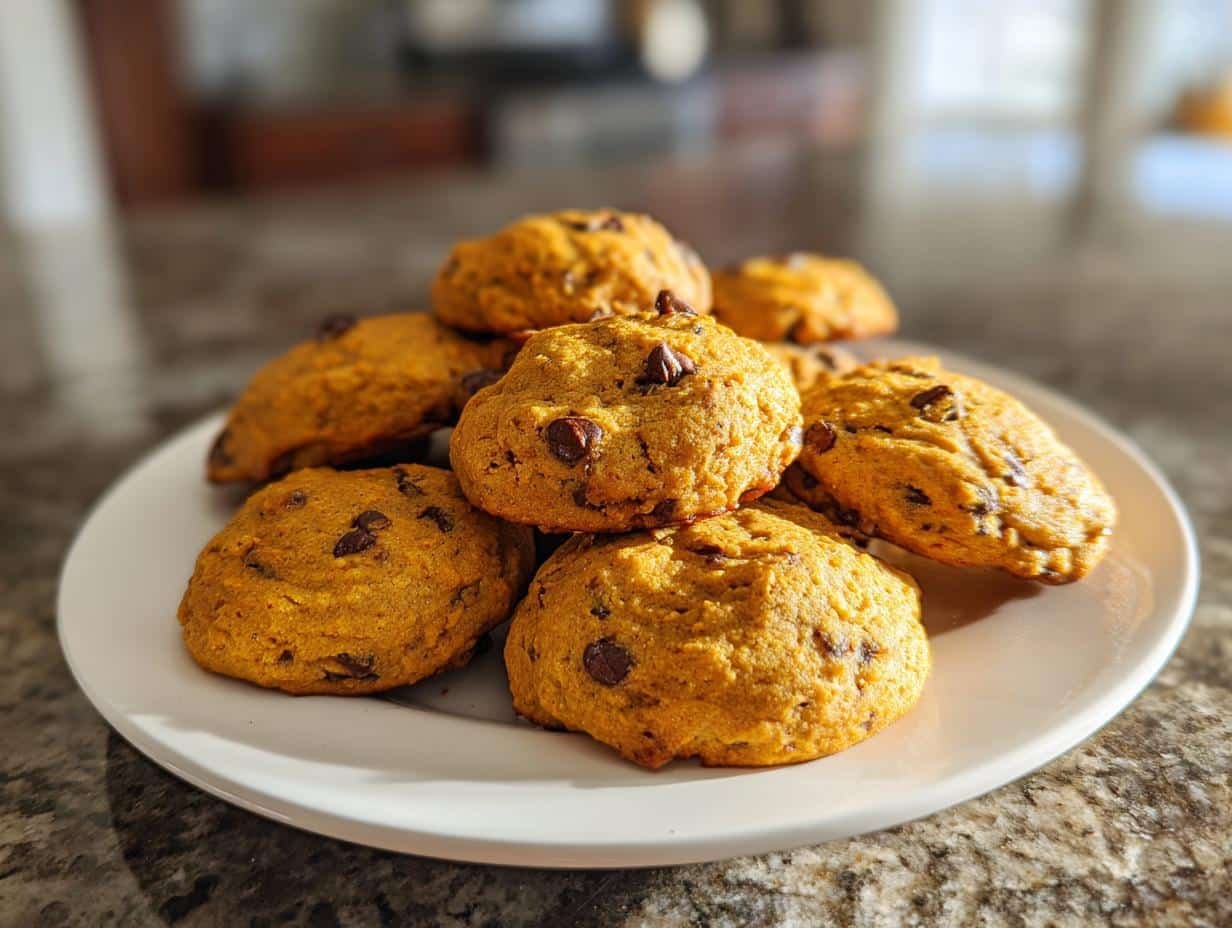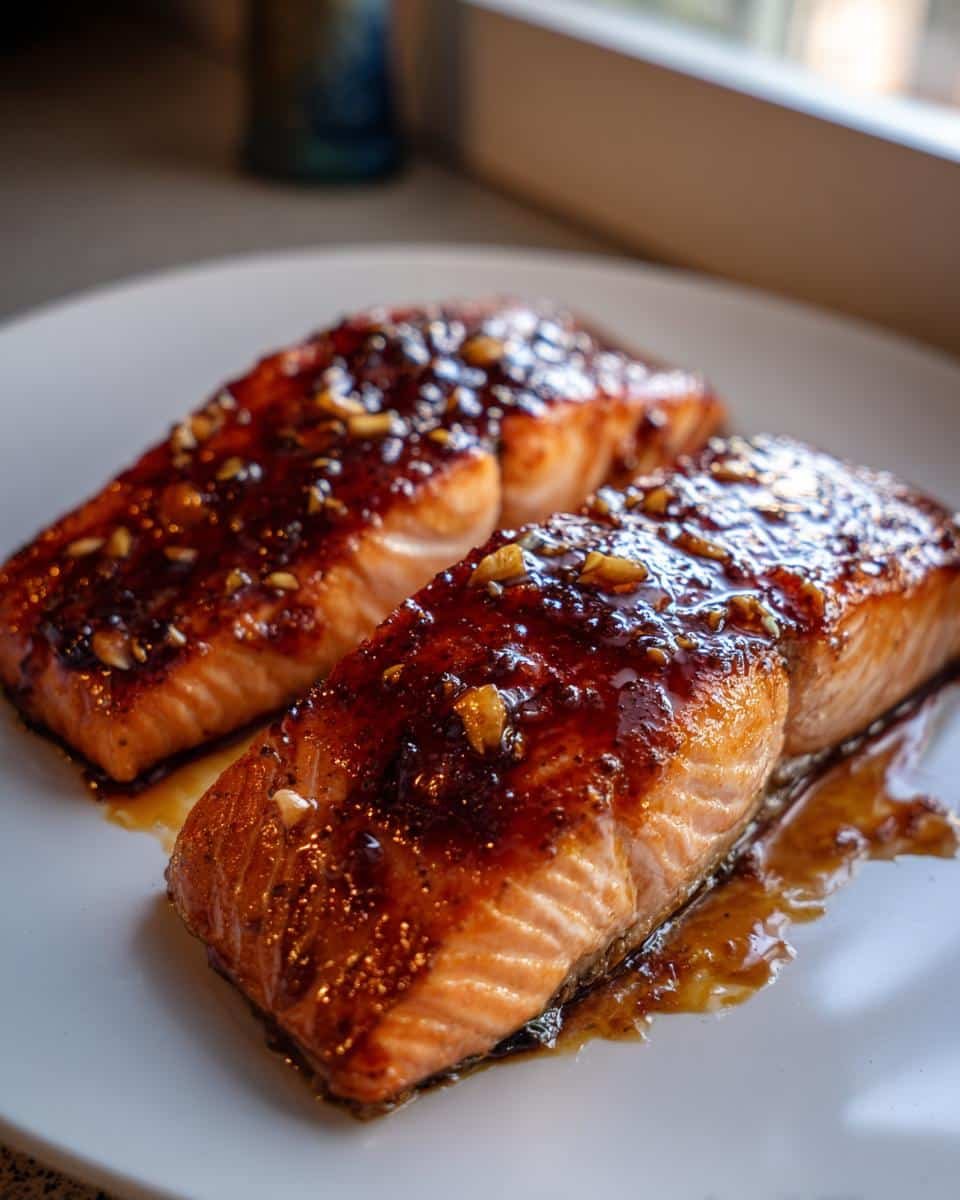If you’re hunting for a quick, delicious way to get veggies and protein in one skillet, this frittata recipe is your go-to. Whether you’re whipping up a casual brunch or making a weeknight dinner stretch, this savory baked egg dish is endlessly flexible. We’ll walk through a step-by-step guide, flavor ideas, and expert tips to get your frittata just right. From farm-fresh veggies to sizzling bacon or vegetarian twists, there’s a version for everyone. Plus, we’ll suggest a few perfect sides to round it out—think spring roll salad with peanut sauce or peach muffins.
Frittata Recipe That’s Quick, Cheesy, and Packed with Veggies
Table of Contents
My Favorite Morning – Why This Frittata Recipe Matters
A Lazy Sunday Story with a Skillet Twist
It all started on a rainy Sunday. I’d planned pancakes, but a peek in the fridge revealed the last of our bell peppers, a few sad zucchini, and exactly 10 eggs. My mom always said, “When in doubt, frittata it out”—so I did. That morning, we sat around the table, cozy and chatting, and dug into something unexpectedly perfect. That’s the magic of a frittata recipe—it doesn’t ask for much but delivers so much comfort. It’s now our weekend staple.
Whether it’s brunch with friends or breakfast-for-dinner with kids, frittatas adapt. You can even prep them ahead and reheat later (yes, it still tastes amazing). And speaking of cozy mornings, if you’re looking for something sweeter to serve alongside, try the blueberry buttermilk pancake casserole—it’s as comforting as it sounds.
What Makes This Frittata Recipe So Versatile
This frittata isn’t just about scrambled eggs in a pan. The secret is in balancing texture and flavor. A good frittata holds its shape but stays creamy inside, thanks to the right mix of eggs and milk. Cheese melts into pockets of richness. Fresh veggies like zucchini, broccoli, and bell peppers bring vibrant color and nutrients.
Bacon adds savory depth, but if you’re going vegetarian, olive oil works just fine. It all comes together in a cast iron skillet—easy to start on the stove and finish in the oven. Want something fresh on the side? This dish pairs beautifully with cucumber tomato salad—a crisp, colorful contrast to the warm, cheesy eggs.

Customizing Your Frittata Recipe with Ingredients You Love
Vegetables That Work Wonders in Frittata Recipes
One of the best things about a frittata recipe is that it welcomes nearly every vegetable you’ve got lying around. Bell peppers, spinach, mushrooms, broccoli, zucchini—they all bring color, texture, and nutrients. Just be sure to cook them down before adding them to the egg mixture. This keeps the frittata from getting watery and ensures every bite is rich, not runny.
Broccoli adds bite and depth (and if you love it, try the easiest broccoli salad as a perfect pairing). Zucchini softens nicely and blends into the eggs, while sweet red peppers brighten the flavor. Leftover roasted veggies? Toss them in! They’ll turn this dish from basic to brilliant.
Protein, Dairy, and Everything Else You Can Mix In
Whether you’re a bacon fan or keeping it plant-based, this dish lets you decide. Crispy bacon adds that irresistible smoky crunch. For a vegetarian version, skip it and sauté veggies in olive oil or butter. Either way, the result will be rich and filling.
Dairy is what sets a great frittata apart. Whole milk or cream adds that velvety texture, and cheese brings the flavor home. Cheddar is classic, but goat cheese, mozzarella, or feta all melt beautifully.
If you’re exploring flavor layers, you might also love something equally protein-packed like these breakfast enchiladas—a bold, baked brunch option that complements the frittata’s smooth texture with spicy energy.
How to Cook a Frittata Recipe That’s Golden and Fluffy
Stovetop Start, Oven Finish – The Winning Method
A classic frittata recipe starts on the stove and finishes in the oven. Here’s why: the stovetop lets you cook your bacon, onions, garlic, and vegetables to perfection first. Once they’re soft and aromatic, it’s time to add the whisked egg mixture. Stir just enough to distribute everything evenly—then stop. You don’t want scrambled eggs.
Let it cook on medium heat for 4–5 minutes. The edges should begin to set while the center stays jiggly. That’s your cue to transfer the skillet to a 425°F preheated oven. This final bake helps the top set and turn a gorgeous golden brown.
Need another hands-off brunch idea? You’ll love the easy frittata recipe for summer brunch, another delicious variation that plays with seasonal flavors and fresh herbs.
Troubleshooting: Avoiding Soggy or Overcooked Frittata
The biggest pitfalls? Too much moisture or overbaking. To avoid these, sauté your vegetables well beforehand. This drives off excess water and keeps your eggs from turning watery.
Also, don’t bake too long. You want the center to just set. Check it after 7 minutes in the oven. A knife inserted near the center should come out clean—but slightly moist.
Resting the frittata for 10 minutes before slicing is crucial. It gives the custard a moment to settle and makes clean cuts a breeze.
For another one-pan wonder with that same golden finish, check out the honey-lime basil peach fruit salad—a bright and juicy contrast that works well with the richness of baked eggs.
Serving and Storing This Frittata Recipe Like a Pro
Perfect Pairings and Presentation Ideas
The beauty of a frittata recipe is how easy it is to dress up or down. Serve it warm or at room temperature with a few well-chosen sides and you’ve got a complete brunch, lunch, or even light dinner. Try slicing it into wedges and arranging on a platter with fresh herbs on top for a colorful touch.
Pair with a light salad like this cucumber tomato salad for a crisp, juicy bite that cuts through the richness. Or for something slightly sweet and refreshing, offer a serving of peach muffins or even a vibrant fruit salad.
A glass of sparkling water with lemon or a mimosa makes it feel like a celebration—even if it’s just Wednesday night.
Leftovers and Make-Ahead Magic
Frittatas store beautifully. Leftovers? Simply wrap slices and refrigerate for up to 4 days. Reheat in the oven at 350°F or pop into a skillet with a splash of water and cover. Microwaving works in a pinch, but reheating in the oven helps preserve the texture better.
Planning ahead? You can cook the veggies and bacon the night before, mix your eggs, and store them separately. Then combine and bake in the morning for fresh frittata with half the effort.
And for easy storage inspiration, consider batch-cooking meals like the mediterranean ground beef stir fry—simple meals with flexible flavors that store just as well.
Print
Frittata Recipe That’s Quick, Cheesy, and Packed with Veggies
- Total Time: 30 minutes
- Yield: 8 slices 1x
Description
A flexible frittata recipe made with eggs, vegetables, cheese, and bacon or olive oil—perfect for any meal.
Ingredients
4 slices bacon (or 2 Tablespoons olive oil for vegetarian)
½ cup onion (diced)
1 teaspoon minced garlic
4 cups vegetables (bell peppers, broccoli, zucchini, etc.)
10 eggs
¼ cup whole milk
½ teaspoon fine sea salt
¼ teaspoon freshly ground black pepper
¼ teaspoon paprika
1 cup shredded Cheddar cheese
Instructions
1. Preheat oven to 425°F.
2. In a bowl, whisk together eggs, milk, salt, pepper, and paprika.
3. Stir in shredded cheese and set aside.
4. In a 10” cast iron skillet, cook bacon, onion, and garlic until lightly browned.
5. Add vegetables, cover and cook until softened.
6. Reduce heat, pour egg mixture into skillet, and stir quickly.
7. Cook on stovetop for 4–5 minutes until edges are set.
8. Transfer skillet to oven and bake for 7–10 minutes.
9. Cool for 10 minutes before serving.
Notes
You can use any vegetables you have on hand.
Make it vegetarian by using olive oil instead of bacon.
Serve warm or at room temperature. Reheats well.
- Prep Time: 10 minutes
- Cook Time: 20 minutes
- Category: Breakfast, Brunch
- Method: Baked
- Cuisine: American
Nutrition
- Serving Size: 1 slice
- Calories: 214
- Sugar: 4g
- Sodium: 391mg
- Fat: 15g
- Saturated Fat: 6g
- Unsaturated Fat: 8g
- Trans Fat: 0g
- Carbohydrates: 7g
- Fiber: 2g
- Protein: 13g
- Cholesterol: 227mg
Frequently Asked Questions (FAQs)
What’s the difference between a frittata and an omelet?
A frittata is started on the stove and finished in the oven, allowing it to cook slowly and evenly, often with fillings mixed into the eggs. An omelet is cooked quickly on the stove and folded over fillings.
Can I make a frittata recipe dairy-free?
Yes! You can skip the milk entirely or replace it with a plant-based option like almond or oat milk. Use dairy-free cheese, or leave it out if preferred.
How do I know when the frittata is done baking?
The center should look set and lightly puffed. A knife inserted near the center should come out clean but slightly moist. It should not jiggle when you shake the pan gently.
Can I freeze frittata leftovers?
Absolutely. Let slices cool completely, wrap tightly in foil or freezer bags, and freeze for up to 2 months. Reheat in the oven or toaster oven for best texture.
Conclusion
This frittata recipe isn’t just easy—it’s endlessly flexible, satisfying, and delicious. Whether you’re feeding a crowd or meal-prepping for the week, it’s a flavorful way to bring veggies, protein, and comfort into one skillet. Add your favorite sides like a crisp salad or sweet muffin, and you’ve got a meal worth repeating. I hope this becomes a regular part of your kitchen routine, just like it has in mine.
Ready to whip one up? Let’s make something amazing together.



